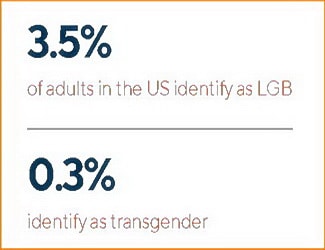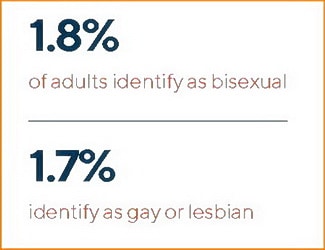(Originally posted Jan 14, 2014)
The San Francisco Gate newspaper quotes the work of a large study that “three out of 4 [gay] people described non-monogamy as a positive thing…“, and the NEW YORK TIMES mentions this:
…New research at San Francisco State University reveals just how common open relationships are among gay men and lesbians in the Bay Area. The Gay Couples Study has followed 556 male couples for three years — about 50 percent of those surveyed have sex outside their relationships, with the knowledge and approval of their partners.
That consent is key. “With straight people, it’s called affairs or cheating,” said Colleen Hoff, the study’s principal investigator, “but with gay people it does not have such negative connotations.”…
Michael Medved’s article on a recent poll that the above radio show is based on (with emphasis thanks to KICKING THE DARKNESS):
The nation’s increasingly visible and influential gay community embraces the notion of sexual orientation as an innate, immutable characteristic, like left-handedness or eye color. But a major federal sex survey suggests a far more fluid, varied life experience for those who acknowledge same-sex attraction. (from Medved article)
The results of this scientific research shouldn’t undermine the hard-won respect recently achieved by gay Americans, but they do suggest that choice and change play larger roles in sexual identity than commonly assumed. The prestigious study in question (released in March by the National Center for Health Statistics and the Centers for Disease Control and Prevention) discovered a much smaller number of “gays, lesbians and homosexuals” than generally reported by the news media. While pop-culture frequently cites the figure of one in 10 (based on 60-year-old, widely discredited conclusions from pioneering sex researcher Alfred Kinsey) the new study finds only 1.4% of the population identifying with same-sex orientation.
Moreover, even among those who describe themselves as homosexual or bisexual (a grand total of 3.7% of the 18-44 age group), overwhelming majorities (81%) say they’ve experienced sex with partners of the opposite gender. Among those who call themselves heterosexual, on the other hand, only a tiny minority (6%) ever engaged in physical intimacy of any kind with a member of the same sex These figure indicate that 94% of those living heterosexual lives felt no physical attraction to members of the same sex, but the great bulk of self-identified homosexuals and bisexuals feel enough intimate interest in the opposite gender to engage in erotic contact at some stage in their development.
A one-way street
Gay pride advocates applaud the courage of those who “come out,” discovering their true nature as homosexual after many years of heterosexual experience. But enlightened opinion denies a similar possibility of change in the other direction, deriding anyone who claims straight orientation after even the briefest interlude of homosexual behavior and insisting they are phony and self-deluding. By this logic, heterosexual orientation among those with past gay relationships is always the product of repression and denial, but homosexual commitment after a straight background is invariably natural and healthy. In fact, numbers show huge majorities of those who “ever had same sex sexual contact” do not identify long-term as gay. Among women 18-44, for instance, 12.5% report some form of same sex contact at some point in their lives, but among the older segment of that group (35-44), only 0.7% identify as homosexual and 1.1% as bisexual.
In other words, for the minority who may have experimented with gay relationships at some juncture in their lives, well over 80% explicitly renounced homosexual (or even bisexual) self-identification by age of 35. For the clear majority of males (as well as women) who report gay encounters, homosexual activity appears to represent a passing phase, or even a fleeting episode, rather than an unshakable, genetically pre-determined orientation.
The once popular phrase “sexual preference” has been indignantly replaced with the term “sexual orientation” because political correctness now insists there is no factor of willfulness or volition in the development of erotic identity. This may well be the case for the 94% of males and 87% of females (ages 18-44) who have never experienced same-sex contact of any kind and may never have questioned their unwavering straight outlook — an outlook deemed “normal” in an earlier age….
…(READ MORE)…
Contemporary research in a less homophobic environment has counterintuitively resulted in lower estimates rather than higher ones. The Williams Institute at UCLA School of Law, a gay and lesbian think tank, released a study in April 2011 estimating based on its research that just 1.7 percent of Americans between 18 and 44 identify as gay or lesbian, while another 1.8 percent — predominantly women — identify as bisexual. Far from underestimating the ranks of gay people because of homophobia, these figures included a substantial number of people who remained deeply closeted, such as a quarter of the bisexuals. A Centers for Disease Control and Prevention survey of women between 22 and 44 that questioned more than 13,500 respondents between 2006 and 2008 found very similar numbers: Only 1 percent of the women identified themselves as gay, while 4 percent identified as bisexual.
[….]
 |
 |
[….]
The study shows that an estimated .3% of Americans are transgender. Additionally, the Williams study shows 3.5% of American adults are gay, lesbian, or bisexual, including 1.8% of American adults who are bisexual.
I will add #4 from my CUMALATIVE CASE below, with an addition from Camille Paglia talking about gender politics at the bottom:
➍ MUTABLE CHARACTERISTICS — Homosexuality is often times due to trauma early in the person’s life. So, for instance, my mom knew quite a few lesbians throughout her life as a hippie/druggy, who now loves Jesus but through life choices lives in a mobile home park… where a few more lesbians are friends with my mom and her husband. She told me that they had all been abused by some older man (often a family member) when they were young. Also, the men I have known well-enough to intimate to me their early lives also have corroborated such encounters (one was a family member, the other not). Which brings me to a quote by a lesbian author I love:
“Here come the elephant again: Almost without exception, the gay men I know (and that’s too many to count) have a story of some kind of sexual trauma or abuse in their childhood — molestation by a parent or an authority figure, or seduction as an adolescent at the hands of an adult. The gay community must face the truth and see sexual molestation of an adolescent for the abuse it is, instead of the ‘coming-of-age’ experience many [gays] regard it as being. Until then, the Gay Elite will continue to promote a culture of alcohol and drug abuse, sexual promiscuity, and suicide by AIDS” (Tammy Bruce, The Death of Right and Wrong: Exposing the Left’s Assault on Our Culture and Values [Roseville: Prima, 2003], 99).
You see, much like this man who had a sex operation, lived as a woman for 8-years, and then was forced to deal with his early life after taking some courses to get a degree in counseling via U.C. Irvine, his gender problems came because of trauma at a young age (Walt Heyer). To put a stamp of approval via society on a “choice” that is caused by anothers “choice” in making these relationships equal, is doing more harm to the individual that good (as Walt Heyer also points out in his book, mentioned in the link). Many have changed their sexual orientation from gay to hetero, as shown above. But if this is the case, then it is very UNLIKE ethnic origins (an ex-gay tells his story): YOUTUBE; a man raised by lesbians and who’s own early sexuality was in flux tells his story: YOUTUBE).
Alan Shlemon talks about the mutability of homosexuality (via STR):
…One study followed approximately 10,800 adolescents between the ages of 16 and 22 years old. Of the 16 year-old males who had exclusively SSA, 61% had opposite-sex attraction at age 17. For same-sex attracted females, 81% changed to opposite attraction in just one year.
The study also compared sexual attraction at ages 17 and 22, with similar results. For example, 75% of adolescent males with SSA at age 17 had opposite-sex attraction at age 22.
Dr. Neil Whitehead, a research scientist who worked for the New Zealand government for 24 years and the United Nations for another four years, analyzed this study. He notes that although a small percentage of heterosexual adolescents developed homosexuality, the vast majority transitioned in the opposite direction. Based on the data, 16 year-olds with SSA are “25 times more likely to change towards heterosexuality at the age of 17 than those with a heterosexual orientation are likely to change towards bi-sexuality or homosexuality.” That means that heterosexuality is 25 times more stable than homosexuality. It also seems to suggest that heterosexuality is more of a “default” orientation…
See more specifics at GIRLS JUST WANNA HAVE GUNS
THE LOVING thing to do is to allow society to not make the private actions of individual illegal, but not to normalize these actions when there is another root cause, or a combination of root causes, other than genetics.
A liberal society might, then, find it prudent to ignore homosexuality. It might well deem it unwise to peer into private bedrooms. However, this is not the issue before us. Today the demand is that homosexuality be endorsed and promoted with the full power of the law. This would require us to abandon the standard of nature, the one standard that can teach us the difference between freedom and slavery, between right and wrong. (SOURCE)
